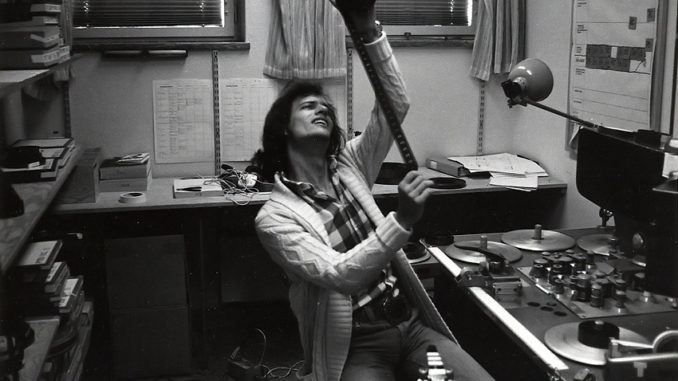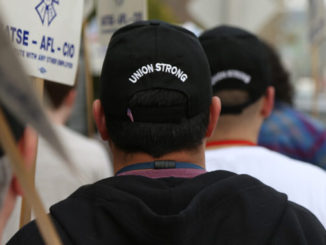
by Louis Bertini, MPSE

Although this is the 70th anniversary of the Motion Picture Editors Guild, the editors union in New York was not founded until 1943. So technically, we in the Eastern Region should not be celebrating our 70th for another six years. But since there is now one merged national union, we are proud to join in the festivities. In honor of the occasion, I thought it would be an appropriate moment to wax nostalgic and take a brief look back at the history of New York Local 771––and some of the Business Agents who ran it.
During World War II, the newsreel industry in New York employed many picture editors. A petition was made to the IATSE for labor representation. In 1943, a charter was granted and Editors Union Local 771 was born. Morrie Roizman, a documentary editor at The March of Time, was elected the first President. Within a year, the workload of the union grew rapidly, and was more than could be handled by the Executive Board. A decision was made to hire a Business Agent. Unlike Local 776 in Los Angeles, where the Business Agent (now known as the Executive Director) is chosen and hired by the Executive Board, the Business Agents in Local 771 were elected by a vote of the entire membership.
In 1945, Charley Wolfe, a newsreel editor, became the first Business Agent, and held that position until 1957. Wolfe accomplished many things in his time in office, including negotiating contracts with the major television networks and commercial houses. He negotiated the first Independent Feature Agreement contract, which was the prototype of the same Independent Feature Agreement we use today in the Eastern Region. He was good at his job, but was a poor public speaker. When he was asked a difficult question at a union membership meeting, he would often hem and haw, and appear noticeably flummoxed. His assistant was a man named Jack Oxton. Wolfe would yell out, “Jack, you tell them the answer!” And Jack always had the answer. So in 1957, Oxton ran against Wolfe for the position of Business Agent. The election results put Oxton ahead by seven votes. Wolfe protested. A second election was held and this time Oxton won by 100 votes.
By all accounts, Oxton was a very elegant man. He wore expensive suits and spoke eloquently. His highest accomplishment took place in 1957 when he negotiated the creation of the Local 771 Pension and Welfare Plans. The membership loved him. After serving for a number of years, he asked the membership at a union meeting to vote him a $100-per-week raise. A member stood up and said, “I move we make it $200!” Another added, “I move we make it $300!” Then another exclaimed, “I move we make it $400!” But in the end, Oxton replied, “No, no, no––$100 is all we can afford and that’s all I want.” He remained as Business Agent until 1969. He was found one day slumped over at his desk, dead from a heart attack.
Fred Ahrens was the Local’s President at that time. He stepped into the Business Agent’s job to take over for Oxton and served until 1972, when he was obliged to resign due to health problems. There then followed a procession of Business Agents who held office for short periods of time. They all had the best of intentions, and believed firmly in the mission of the union, but for various political reasons they encountered difficulties accomplishing their goals: Walter Sampson (1972-1974), Dave Roland (1975-1976), Joel Ap-pell (1976) and Sy Gru (1977-1978).
By 1989, the work situation in New York began to change. The networks had eliminated almost all of their film jobs and switched everything to videotape.
Eugene Shapiro was involved with the union for many years, and in many different capacities. He served as a Shop Steward, Committee Chair-man, Assistant Busi-ness Agent, Pension and Welfare Trustee and Convention Delegate. He was elected Business Agent in 1978. Although he only served one term, he had an impressive list of accomplishments, including the creation of formalized procedures for members to air their grievances, and for the enforcement of contract compliance. He also negotiated the 35-hour workweek into the Basic Standard Agreement.
Since this was the period when videotape was overtaking film jobs at the networks––where many of our members were employed––Shapiro sponsored the creation of the union’s first technology retraining program. As a Pension and Welfare Trustee, he helped to establish full financing for vested pension obligations as well as the union’s first dental plan. He also initiated negotiations for the creation of a contract with the major studios, which was to be completed by the next administration.
Up until that point, the Local 771 Business Agents had all come from the union rank and file. The difficulties encountered by the preceding short-term administrations fostered the idea that the union really needed a person with professional labor experience. Bill Bender was a successful Organizer with the Teamsters, and Gru recruited him to work as an Organizer for 771. Later on, Shapiro hired him as his Assistant Business Agent. Bender ran against his boss in 1980 and won the job.
Bender held the position of Business Agent for 10 years. These were very busy years for the Local. It was the period of our highest level of membership. By 1987 more than 1,200 people were working in features and at the networks. They were also very busy years for Bender. He was a tough negotiator and delivered many contracts. He finalized the Majors Contract, which was New York’s first formal agreement with the Association of Motion Picture and Television Producers (AMPTP). He negotiated the Collaborating Editor clause into the Major and Independent Agreements, which protected New York’s editing jurisdiction. In 1980, he fought off a feature film strike, but the following year oversaw a year-long strike against Time-Life, the longest strike in the Local’s history.
Our members had a solid impact on the cultural life of New York City in the second half of the 20th century. Their stories deserve to be remembered.
By 1989, the work situation in New York began to change. The networks had eliminated almost all of their film jobs and switched everything to videotape. Since 771 did not hold those contracts, many members were put out of work and left the union. The crews in feature work also began to downsize, owing to technology changes. Many more members left 771, or moved to its West Coast counterpart, Local 776. The size of the membership shrank rapidly, and by 1990 was down to around 700 people. Bender felt the effects of these difficulties and his relationship with the Board deteriorated. He resigned in 1990.
The Board then appointed Ken Werner, the Assistant Business Agent, to fill the job. He served until 1991, but did not intend to keep the position, so did not run for re-election. That year, the membership elected a person who had never worked in editing, and had never worked for the Executive Board or any of its employees. He would also prove to be the last Business Agent of Local 771.
William R. Hanauer spent an early part of his career in the theatre––as an actor and stage designer. He had a great interest in social issues, and became very involved in the social politics of New York. He was elected Associate Business Agent of IATSE Local 798, and used his success in that position to win the job with 771. He quickly set to work modernizing the methods of the union office in ways that it had never before seen, both managerially and technologically.
Because of his theatrical background, Hanauer’s style of speaking had a certain polish that our members were not quite used to––and it took a while for them to adjust. His first re-election campaign two years later was a little hard-fought because of this, and also because the difficult work situations that began at the end of the Bender years had not really subsided. But he did win again, and ultimately cemented his position with the members.
At the time Hanauer first took office, the 771 Welfare Plan was suffering from the effects of runaway inflation and poor management by the previous Trustees. The Plan was six months away from bankruptcy. He negotiated a very large increase in employer contributions to the Majors and Independent contracts, and oversaw the restructuring of the Pension and Welfare Plans finances, bringing them back to a sound footing. In 1991, I joined him in this work when I was elected a Pension and Welfare Trustee.
Since there is now one merged national union, we are proud to join in the festivities.
Hanauer oversaw many more successful contract negotiations. As the ‘90s progressed, the work situation in New York improved, and 771 began to grow again. His final negotiation, in 1998, was with Local 776, which led to our national merger––and the creation of Local 700. He has since left the arena of Labor and has now officially entered the field of politics when he was elected last November as the Mayor of Ossining, New York.
The Guild’s New York office is currently headed by Local 700 Assistant Executive Director Paul Moore.
There is obviously a lot more to this history than can be covered in this column. It deserves a detailed telling in full book form. The Guild has a History Committee that is presently hard at work interviewing our retired members and documenting their stories for our archives.
Our members did more than contribute to the motion picture, documentary and television business; they had a solid impact on the cultural life of New York City in the second half of the 20th century. Their stories deserve to be remembered.
(Thanks to Louis Cerborino, Bill Elias, Sandy Fong-Ging, Peter Frank, Alan Heim, Marc Laub, Yvette Nabel, Eugene Shapiro and Ted Troll for their help in recalling these events.)





